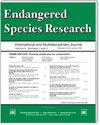通过环境 DNA 线粒体标记评估墨西哥雅基河流域濒危雅基鲶鱼的潜在栖息地
IF 2.9
2区 环境科学与生态学
Q2 BIODIVERSITY CONSERVATION
引用次数: 0
摘要
摘要:获取稀有和受威胁物种的数据具有挑战性,尤其是在偏远地区。与物理鱼类取样方法相比,环境 DNA(eDNA)是一种耗费精力较少的物种检测方法。在我们的研究中,我们重点研究了濒危的雅基鲶鱼 Ictalurus pricei(一种美国亚利桑那州和墨西哥索诺拉州索诺兰沙漠特有的淡水鱼)和非本地的沟鲶鱼 I. punctatus。我们开发并利用线粒体 eDNA 标记对墨西哥雅基河流域的 35 个地点进行了采样,并采用分层贝叶斯共同出现模型来研究物种之间的相互作用,同时考虑协变量对物种占据和检测的影响。我们的最佳模型包括河沟鲶线粒体 eDNA 对检测到雅奎鲶线粒体 eDNA 的影响,我们发现河沟鲶线粒体 eDNA 的检测与水温和海拔呈负相关,但与底质大小呈正相关。根据线粒体 eDNA 的检测结果,溪流的永久性和林区的存在最能解释雅基鲶鱼的栖息情况,而沟渠鲶鱼线粒体 eDNA 的出现也与溪流的永久性以及针叶树和灌木为主的地貌有关。除了 5 个检测到雅奎鲶鱼线粒体 eDNA 的地点外,在其他所有地点都发现了非本地的河沟鲶鱼线粒体 eDNA,这表明存在相互作用和杂交的可能性很大。这种杂交的可能性对已经濒临灭绝的雅基鲶构成了重大威胁,强调了保护和确保剩余种群长期生存的必要性。本文章由计算机程序翻译,如有差异,请以英文原文为准。
Environmental DNA mitochondrial markers to assess potential occupancy of Endangered Yaqui catfish in the Yaqui River basin, Mexico
ABSTRACT: Acquiring data on rare and threatened species can be challenging, particularly in remote areas. Environmental DNA (eDNA) offers a less effort-intensive method for detecting species compared to physical fish sampling methods. In our study, we focused on the Endangered Yaqui catfish Ictalurus pricei, a freshwater fish endemic to the Sonoran desert in Arizona, USA, and Sonora, Mexico, and the non-native channel catfish I. punctatus. We developed and employed mitochondrial eDNA markers to sample 35 locations in the Yaqui River basin in Mexico and employed a hierarchical Bayesian formulation of a co-occurrence model to investigate the interactions between the species while accounting for the effects of covariates on species occupancy and detection. Our best model included the influence of channel catfish mitochondrial eDNA on detecting Yaqui catfish mitochondrial eDNA, and we found that channel catfish mitochondrial eDNA detection was negatively related with water temperature and elevation but positively related to substrate size. Yaqui catfish occupancy, as determined with mitochondrial eDNA detection, was best explained by stream permanence and the presence of forested areas, while channel catfish mitochondrial eDNA occurrences were also associated with stream permanence, as well as conifer and shrub-dominated landscapes. Non-native channel catfish mitochondrial eDNA was found in all but 5 locations where Yaqui catfish mitochondrial eDNA was detected, indicating a high likelihood of interaction and hybridization. This potential for hybridization poses a significant threat to the already Endangered Yaqui catfish, emphasizing the need to protect and secure remaining populations for their long-term survival.
求助全文
通过发布文献求助,成功后即可免费获取论文全文。
去求助
来源期刊

Endangered Species Research
BIODIVERSITY CONSERVATION-
CiteScore
5.50
自引率
6.50%
发文量
38
审稿时长
31 weeks
期刊介绍:
ESR is international and interdisciplinary. It covers all endangered forms of life on Earth, the threats faced by species and their habitats and the necessary steps that must be undertaken to ensure their conservation. ESR publishes high quality contributions reporting research on all species (and habitats) of conservation concern, whether they be classified as Near Threatened or Threatened (Endangered or Vulnerable) by the International Union for the Conservation of Nature and Natural Resources (IUCN) or highlighted as part of national or regional conservation strategies. Submissions on all aspects of conservation science are welcome.
 求助内容:
求助内容: 应助结果提醒方式:
应助结果提醒方式:


